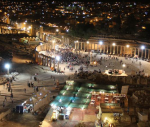You are here
Syria’s declared chemical arms ‘100% destroyed’ — watchdog
By AFP - Jan 06,2016 - Last updated at Jan 06,2016
THE HAGUE — Syria’s declared chemical weapons arsenal has been completely destroyed capping more than two years of work, a global arms watchdog said Tuesday, amid concern sarin gas is still being unleashed in the country’s complex civil war.
The Organisation for the Prohibition of Chemical Weapons (OPCW) — which oversaw the dangerous removal and elimination of Syria’s avowed stockpile — has for months been warning of the continued use of mustard, sarin and chlorine gas in the brutal conflict.
But it has avoided blaming either the regime of Syrian President Bashar Assad, the rebels or the Daesh group for the use of the weapons banned under international law.
After years of denials, the regime caved to international pressure in September 2013 and agreed under a US-Russia deal to hand over its toxic stockpile to the OPCW for destruction.
The admission came after a sarin gas attack in August that year on rebel-held areas near Damascus that was blamed by the West and the opposition on the regime. Hundreds of civilians were killed.
The removal of the weapons was the result of a historic deal which averted threatened US air strikes against Damascus after the August attacks.
“One hundred per cent has been destroyed,” Malik Ellahi, the OPCW spokesman, told AFP on Tuesday.
With the UN Security Council poised to discuss the chemical weapons issue on Tuesday, OPCW Director General Ahmet Uzumcu, said: “This process closes an important chapter in the elimination of Syria’s chemical weapon programme.”
But he acknowledged the organisation based in The Hague was still continuing “efforts to clarify Syria’s declaration and address ongoing use of toxic chemicals as weapons in that country”.
In a separate report released Monday after being sent to the Security Council last week, the watchdog said it was investigating 11 incidents reported by the Syrian government in which people may have been exposed to sarin or sarin-like gas.
“Further investigation would be necessary to determine when or under what circumstances such exposure might have occurred,” the report said.
Previous fact-finding missions by the OPCW in Syria have pointed to the use of chlorine and mustard gas.
Source of arms unknown
Both the regime and the so-called Daesh group have been accused of using chemical weapons in the war, although it remains unclear where the arms have come from.
Under the terms of a deal hammered out in Geneva in September 2013 by US Secretary of State John Kerry and his Russian counterpart Sergei Lavrov, Syria finally admitted to possessing over 1,000 tonnes of chemical weapons and agreed to hand them over for destruction.
Under the agreement, Syria’s entire chemical arsenal had been due to be eliminated by June 30, 2014, and all chemical effluent by December 31, 2014.
But the timetable slipped badly amid protractions by the Assad regime and complications posed by the nearly five-year civil war which has claimed more than 250,000 lives.
The last remaining vestiges of the regime’s declared stockpile — some 75 cylinders of highly corrosive hydrogen fluoride — were destroyed by the US firm Veolia at its treatment plant Port Arthur in Texas, the OPCW said.
“This completes destruction of all chemical weapons declared by the Syrian Arab Republic,” the OPCW said in a statement issued Monday.
“The need to devise a technical solution for treating a number of cylinders in a deteriorated and hazardous condition had delayed the disposal process,” it added.
The first shipment of chemical weapons left Syria from its Port of Latakia in January 2014.
A total of 1,300 metric tonnes of chemical weapons have now been removed from Syria, with the majority neutralised on the US Navy ship MV Cape Ray and turned into less harmful effluent.
The OPCW’s work in Syria saw it being awarded the Nobel Peace Prize in 2013.
Related Articles
In just over a month, Syria is supposed to have rid itself entirely of its chemical weapons programme and the 1,300-metric tonne stockpile of mustard gas and precursor chemicals it declared to the global watchdog overseeing the destruction. But the June 30 deadline, agreed upon last year, now appears out of reach.
The last of Syria’s declared chemical agents have been shipped from the war-torn country after months of delays and are en route for destruction at sea, the world’s chemical watchdog said on Monday.
Syria maintains an ability to deploy chemical weapons, diplomats say, citing intelligence from Britain, France and the United States that could strengthen allegations Syria’s military recently used chlorine gas in its bloody civil war.

















